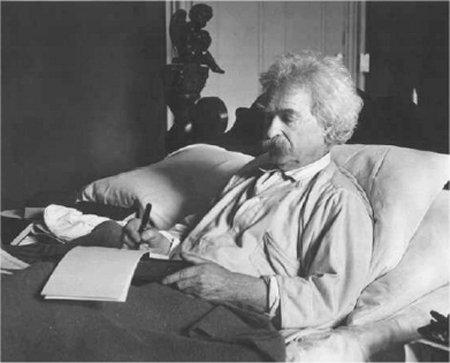
- American author and humorist Samuel Langhorne Clemens, well-known by his pen name of “Mark Twain,” served as a steamboat pilot on the Mississippi River until the American Civil War broke out in 1861. The Mark Twain image shown here adorns an early Twentieth Century cigar box. Mark Twain was beloved and enjoyed public goodwill all his days.
I used to have a notion that there was only one place in the world where I could write,” American author Mark Twain once told a friend, “That was Elmira, where I used to spend all my summers. But I’ve got over that notion now. I find that I can write anywhere.” (1)
Anywhere meant exactly that: anywhere. Twain didn’t even require a desk to write. As it turns out, Mark Twain (1835-1910), also known as Samuel Clemens, did a good deal of his writing in bed. Unlike many other authors who complained of the difficulty of the writing process, Twain did not find creative work difficult.
Just try it in bed sometime. I sit up with a pipe in my mouth and a board on my knees, and I scribble away. Thinking is easy work, and there isn’t much labor in moving your fingers sufficiently to get the words down.” (1)
In his old age, Mark Twain was often photographed in his heavenly bed, smoking away on a cigar or a pipe and writing.
While Twain had many houses in his lifetime and all of them special, he had but one favorite bed, which he kept with him all of his life. He had bought it in 1878 in Venice, Italy, when he and his wife Olivia were furnishing their ridiculously- expensive three-story Victorian palace in a Hartford, Connecticut neighborhood known as “Nook Farm.”

The Mark Twain House in the Hartford, Connecticut, community known as "Nook Farm." Mark Twain said of this house, "To us, our house . . . had a heart, and a soul, and eyes to see us with." (Mark Twain Wrote (and Smoked!) in Bed," Lisa's History Room)
The master bedroom at Nook Farm occupied its own wing on the second floor. The massive Venetian oak bed dominated the room. The bed was heavy and made of carved oak. It featured:
a headboard carved into a bas-relief of cupids, nymphs and seraphs, the six-wing angels who guard God’s throne. [Twain] claimed he found it so sublime he had put the pillows down at the foot of the bed and slept backward so that this heavenly vision of worldly success would be the first thing he saw every day when he awoke.” (2)
It was in this bed that Twain died. (3) The bed remains the most famous furnishing of the Mark Twain House in Hartford, Connecticut. This house proved so costly to furnish and maintain that it drove Twain into bankruptcy in 1891. He was forced to go on tour in Europe to raise funds.
However foolhardy the house was, it was during those spendthrift years at Nook Farm that Twain wrote many of his best-known and most-loved works, probably while smoking in his favorite heavenly bed:
- The Adventures of Tom Sawyer (1876),
- The Prince and the Pauper (1881),
- Life on the Mississippi (1883),
- Adventures of Huckleberry Finn (1884), and
- A Connecticut Yankee in King Arthur’s Court (1889). (2)
(1) “How Mark Twain Writes in Bed. The New York Times, April 12, 1902.
(2) Wolfe, Tom. “Faking West, Going East.” The New York Times, April 24, 2010.
(3) Power, Ron. Mark Twain: A Life. New York: Free Press, 2005.





















